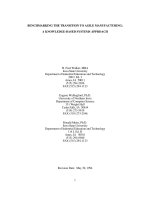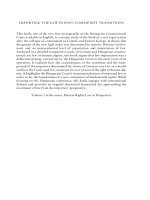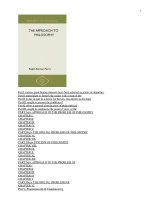- Trang chủ >>
- Cao đẳng - Đại học >>
- Luật
The Last Lawyer The Fight to Save Death Row Inmates
Bạn đang xem bản rút gọn của tài liệu. Xem và tải ngay bản đầy đủ của tài liệu tại đây (851.06 KB, 241 trang )
THE
LAST
LAWYER
THE
LAST
LAWYER
The Fight
to Save
Death Row
Inmates
John Temple
University Press of Mississippi / Jackson
www.upress.state.ms.us
The University Press of Mississippi is a member
of the Association of American University Presses.
Copyright © 2009 by John Temple
All rights reserved
Manufactured in the United States of America
First printing 2009
∞
Library of Congress Cataloging-in-Publication Data
Temple, John, 1969–
The last lawyer : the fight to save death row inmates /
John Temple.
p. cm.
ISBN 978-1-60473-355-6 (cloth : alk. paper) 1. Rose,
Ken, 1956– 2. Jones, Levon. 3. Death row inmates—
North Carolina. 4. Trials (Murder)—North Carolina.
5. Capital punishment—United States. I. Title.
HV8701.J66T46 2009
364.66092—dc22
2009010826
British Library Cataloging-in-Publication Data available
“Every lawyer gets at least one case in his lifetime
that affects him personally. This one’s mine, I guess.”
—ATTICUS FINCH, To Kill A Mockingbird, by Harper Lee
This page intentionally left blank
THE
LAST
LAWYER
This page intentionally left blank
MISSISSIPPI STATE PENITENTIARY
AT PARCHMAN
June 21, 1989
The roads around Parchman Farm run straight as the flight of a bullet. Even
at sixty miles per hour, the flat cotton fields of the Mississippi delta stretch
motionless in the distance. Clusters of convicts in bright white jumpsuits
and red caps work the fields, hoes swinging up and chopping down in
ragged tandem. Over the rush of wind come snatches of a baritone work
song or the bark of an order from a White Hat guard slouched in his saddle,
a .45 on his hip.
Ken Rose had made the long drive from Jackson to the penitentiary
work farm in Parchman dozens of times over the previous five years, often
picking up a bucket of fried chicken along the way to share with a client.
The young lawyer had spent untold hours in the visiting room, hunching
slightly to peer through the shoebox-sized hole in the metal grate. Sometimes he played chess with a privileged inmate on one of the benches in
the scorching penitentiary yard. Or, if the client wanted to stretch his legs,
they’d play one-on-one on the hard-packed red dirt basketball court with
its lone hoop and chain-link fences topped with barbed wire.
The basketball court was on the same side of C Tier as the death
house. The small square annex topped with a tall white chimney had been
3
4
The Last Lawyer
used only three times since 1964, so rarely that the penitentiary officers
ran numerous mock gassings before each execution, fretting that they’d
slip up during the real thing and kill themselves. During some test runs,
they would put a wild rabbit from the cotton fields in the chamber, just to
be sure the gas was working. The gas chamber itself, built in 1954, was an
odd contraption, a six-sided metal pod that looked like an antique from a
NASA museum, all silver rivets and long windows. It was built into a wall
so that half of the chamber protruded into the room where witnesses sat.
The other half opened into an operations room where the guards mixed the
lethal blend of chemicals.
On this balmy summer night in 1989, Ken entered the witness room of
the death house. Rows of metal folding chairs sat on risers, and Ken took
a seat near Leo Edwards’s daughter and mother. Black drapes covered the
gas chamber windows, but the audience could hear guards moving around
inside.
Two years earlier, another of Ken’s clients, Edward Earl Johnson, had
been asphyxiated here. Johnson’s execution had attracted great public concern. A BBC documentary crew had spent two weeks at the prison filming
Johnson and other inmates and corrections officers as they prepared for
the execution. Seventy protestors had sung hymns and lit candles outside
the prison and the governor’s mansion in Jackson. The prison warden who
executed Johnson quit corrections soon afterward and became an abolitionist, speaking and writing against the death penalty.
But now, the hubbub was markedly quieter. Just a handful of protestors
had gathered outside the prison gates for Leo Edwards. The case had also
attracted fewer headlines. Leo wasn’t as sympathetic as the thick-glassed,
soft-voiced, chess-loving Johnson, whom many thought was innocent. Leo
had admitted to killing a convenience store clerk in 1980, one death in a
spree of killings he committed after breaking out of Angola.
An all-white jury had sentenced Leo to death. Then Ken had taken on
the case and obtained records showing that the prosecutor in the case had
systematically excluded blacks from his juries over many years. Ken put a
statistician on the witness stand before the U.S. Court of Appeals for the
Fifth Circuit to analyze the astronomical odds that the exclusions could be
coincidental. In a deposition, the prosecutor had acknowledged that it was
his strategy to exclude as many blacks from his juries as possible. It had
taken months of hard work, but Ken believed his team had built a nearperfect case of racial discrimination. There was no way the Fifth Circuit
The Last Lawyer
5
would uphold a death sentence given by a jury that had been methodically
purged of blacks.
But Ken and Leo had lost the appeal. And a few hours earlier, one of
the governor’s men pulled Ken aside and said that the governor would not
grant clemency.
When Ken gave Leo the news, the inmate thanked Ken for his work.
Just keep fighting, Leo said. For the others.
The gracious words only made Ken feel worse. Leo Edwards was the fourth
execution in Mississippi and the 113th in the nation since the Supreme Court
had resurrected the death penalty in 1976. It was a trickle, but a trickle
that would grow. Fifty men sat on Mississippi’s death row, and those cases
would ripen. He couldn’t fight them all.
Leo had requested a sedative, and the guards had half-carried him to
the death house a few minutes after midnight. When an officer pulled back
the black drapes, Ken could see his groggy client sitting on a heavy metal
mesh chair inside the metal pod. Six thick harness-leather straps held down
his arms and legs. A belted cap pinned Leo’s head to a pole in the center of
the chamber. The prison had installed the custom-fabricated head restraint
after a previous inmate in the throes of cyanide asphyxiation involuntarily
pounded his head against the pole.
Ken watched, sick with rage and disbelief. This made no sense. By
any measure, he’d established the case that, despite his guilt, Leo deserved
another jury, another opportunity for a life sentence. But no one listened,
and now they were methodically, carefully preparing to kill Leo.
Ken had worked for months, preparing for every turn the case could
take. Except this. He wasn’t prepared for this.
A guard poured cyanide crystals from a thick brown bottle into a
container below the chair, then dashed out of the chamber and closed the
300-pound airtight metal door. The door whooshed, a lever clanked, and
the cyanide salts plopped into a sulfuric bath. A fan in the ceiling buzzed,
beckoning the bitter almond-scented gas upward. The witnesses could see
it rising, like steam from a hot shower.
The vapor haloed around Leo’s head, and the inmate slumped against
his restraints.
Moments later, to everybody’s shock, Leo’s frame stiffened and his eyes
opened. He stared straight into the witness room. He cried out twice and
began to buck wildly against the restraints. For long agonizing moments,
Leo jerked spasmodically in the chair. Despite the leather head restraints,
6
The Last Lawyer
he drove his head against the pole, over and over, as Ken flinched in his
own chair.
■ ■ ■
That night, Ken Rose lost faith in the system, even as he continued to work
within it. Years later, the execution of Leo Edwards haunted and angered
him more than any other experience. This puzzled Ken’s wife, Beth, who felt
more sympathy for the boyish and soulful and possibly innocent Edward
Earl Johnson than for Leo Edwards, a hardened career criminal. But Ken
couldn’t shake the vision of Leo thrusting his head against the pole, and he
felt even more horrified by this execution than Johnson’s.
Before Leo’s death, Ken thought he knew the death penalty system.
Since graduating from law school, he’d apprenticed with some of the finest
capital-law specialists before striking out on his own in Mississippi. He’d
studied the rules and thought he’d seen it all. But a grim truth had made
itself known to him on the night Leo died, a truth his logical mind found
difficult to grasp.
Any case could be lost.
No matter how hard he worked, no matter how sound his argument,
no matter how compelling the facts, those things alone could not guarantee
his client’s life. Not if he got the wrong judge, or if the political atmosphere
was working against him. Ken could build a case as airtight as the Parchman gas chamber, and he might still find himself watching helplessly as his
client strained against the leather straps, suffocating.
Ken Rose was thirty-two years old the night Leo Edwards died, and
after eight years of capital law, his education was complete.
PART 1
1997–1999
This page intentionally left blank
1
Heavy boxes in hand, the lawyers shuffled toward the Duplin County
Courthouse. The old building’s brilliant white columns and cupola towered
over the village, high above the red-brick Kenansville Drug Store, the Pizza
Corner, and the Duplin Times newsroom. It was a mild March morning
in 1999, clouds scattered over the coastal plain of North Carolina, and the
legal team felt as confident as lawyers in their particular specialty ever did.
Ken Rose was the lead attorney on the team defending Bo Jones. Ken
was forty-two, a shambling man with bushy black hair, an unevenly cut
mustache, and tired eyes. He managed to look no more distinguished in
his courtroom suit than he did in his customary rumpled khakis and halftucked shirt. He was one of the nation’s leading experts on death penalty
appeals.
Ken’s team included two other attorneys and an investigator. A show
of force. The words of his first mentor in the work, down in Atlanta: Represent your broke death row client like you’re representing Coca-Cola. Ken had
grown up in New Orleans but did not share Millard Farmer’s impossibly
luxurious drawl that stretched the phrase into a syrupy call-to-arms . . .
like you-ah rep-reh-sen-ten Co-cah-Co-lah. Ken lacked Millard’s flamboyant courtroom presence. But over hundreds of visits to Parchman Farm or
Angola, the Louisiana prison cradled in an elbow of the Mississippi River,
Millard’s guiding principle had baked itself into Ken’s skull.
And that was why today he’d brought the whole gang to tiny Kenansville, North Carolina. Ken would spare no expense, no amount of
9
10
The Last Lawyer
legal ingenuity, no amount of time or manpower, to stop—or, more likely,
delay—the execution of Bo Jones, a former farmhand. Ken knew his adversary from the North Carolina attorney general’s office, knew she would take
pride in arguing her case all by herself, one petite law-and-order woman
matching wits with an entire posse of liberal lawyers from Durham.
The boxes the attorneys lugged contained evidence, the investigative
flotsam of the past thirteen months. Photographs of a sprawled gut-shot
old man in a tank top and underwear. Photocopies of notes that a deputy sheriff had scribbled on lined notebook paper during interrogations a
dozen years earlier. Carefully typed statements from mental health experts,
laden with psychiatric jargon. Transcripts of interview after interview with
jurors, witnesses, inmates, relatives.
This painstakingly collected evidence gave the team confidence. It had
already won them two rare victories. One, they’d stalled the long journey to
execution and were back in court. Two, just a few days earlier, their judge
had recused himself, turning the case over to a new judge. Ken’s team had
asked the Honorable Russell J. Lanier Jr. to step down because he regularly
played golf with their client’s former lawyer, who was a target in this case.
Much of the evidence they’d turned up was about the inadequate work the
former lawyer had done. It wasn’t fair, Ken had argued, for this judge to rule
on whether his friend had done a shoddy job of lawyering.
The motion to recuse had carried a risk. If they’d lost and Judge Lanier
had remained on the case, he might have resented the implication that he
couldn’t be impartial. But Ken had decided it was worth the risk to take
the offensive. In the past, Judge Lanier had denied relief in some troubling
cases.
So Ken had exulted when he’d heard a few days earlier that Judge Lanier
had recused himself. The judge wrote that he didn’t want the case to carry
“the appearance of impropriety.” It was one of those incremental triumphs
that nourished the band of attorneys at the Center for Death Penalty Litigation office in Durham. Even better, the newly appointed judge was Charles
Henry, who had been a defense attorney and worked capital cases. If anyone would understand the merits of this case, it was Judge Henry.
And Ken knew the facts they’d amassed were powerful. The Bo Jones
case was unmatched in his long experience. The claims were rich and
broad. They’d piled up over the past year, interview by interview, document
by document. The Bo Jones case was a model of how not to conduct a death
penalty trial. In this hearing, Ken would bring out how poorly the trial had
The Last Lawyer
11
been run and, if things went well, Bo Jones could get a life sentence or a
new trial. He could even walk free, join his brother and sisters back home.
But Ken would not allow himself too much confidence. Each time he
felt himself growing optimistic, he reined in. While strategizing about the
case with the rest of the team, this had happened over and over. They’d
begin to consider positive outcomes, and Ken would end the speculation
with a short declarative expression of doubt. His actions were bold—the
motion to recuse, for example—but he couldn’t afford to dream about winning. He’d suffered too many moments of crushing loss. Like watching Leo
through the gas-chamber glass, buckling and straining against the straps.
Yes, they’d built a powerful case, but Ken had been doing this work too
long to revel deeply in the small victories. He longed for a big one. The big
case Millard and Ken and the others all dreamed of years ago, the one that
would end it for good, the new Furman v. Georgia. The one they’d decided
would never come.
The courthouse rose above the lawyers, but they sidestepped the grand
old building. The hearing was scheduled for a smaller courtroom in a twostory annex to the side of the big courthouse.
The lawyers turned and entered the shoebox-shaped appendage, as
modern and utilitarian as the old building was decorative.
■ ■ ■
The interior of the annex was drab, too. Gray walls and carpeting. Signs
instructed: “No Loud Talking in Hallways” and “No shorts. No Tank Tops.
No hats. Shoes are required.” Shackled defendants from the jail across the
street—drunks and bad-check passers—filled out forms at the clerk of
court window.
Compared to the administrative gray of the hallway, the courtroom
was a burst of jarring color: lime-green carpeting and bright yellow spectator seats that flipped up and down, like stadium seating. The lawyers set up
at a table in the fore of the courtroom.
Ken’s co-counsel was a thirty-year-old woman named Grace McLean.
This was Grace’s first courtroom hearing, and she wished her co-counsel for
this personal milestone was someone other than Ken Rose. Ken had an easy
smile, but Grace wasn’t the only one at the Center for Death Penalty Litigation who had found him difficult to know. He harbored a core of reserve
so deep that they wondered what he thought about other than work. Grace
12
The Last Lawyer
had witnessed those moments when Ken’s smile dropped away, replaced by
something a notch less warm. He’d cock his head and stare down his nose at
the unfortunate object of his attention. They called it his “West Point look.”
All the same, Grace knew they had constructed a solid case. Seven
months earlier, when she and Ken were writing the motion that had landed
them in court, Grace had sorted and highlighted and outlined this evidence a dozen times over. The task had turned her office at the CDPL into
an archive, each stack of files representing an arguable injustice in the case
of Bo Jones. One stack of evidence about Bo’s mental problems. A stack
about his former lawyer’s misdeeds and incompetence. Another about the
sheriff ’s investigative files.
Now, the CDPL team was organizing the evidence once again, making
sure everything in the boxes was easy to reach. As the lawyers set up, Bo
Jones’s sisters and aunts settled into the squeaky flip-down seats behind
him. Ponderous women, they sighed when they sat down. The women
waved and smiled at the CDPL team, but the attorneys knew they were
edgy. They’d all grown up in Duplin County, but they didn’t like coming to
the county seat. Kenansville meant police, jail, court . . . trouble. Nevertheless they came, just as they had sat through that terrible week of trial back
in 1993.
Bo entered the courtroom, flanked by deputy sheriffs, and caught sight
of his aunts and sisters. He smiled and nodded, searching out and studying each familiar face. Felecia stared back, startled by how big her older
brother looked at forty—he’d always been so lean. Now his meaty shoulders packed the white short-sleeved dress shirt the family had brought that
morning. Forearms, belly, jaw—all were heavier, thicker. But his hips were
still narrow in the dark slacks. Sister Mattie had dug the outfit out of their
father’s closet at home. The lawyers had asked her to bring the clothes so Bo
wouldn’t have to dress in the customary jumpsuit from Central Prison in
Raleigh, where he had spent the last six years. The clothes would “humanize” him, the lawyers had said.
From the CDPL table, Grace watched Bo, curious to see what he really
looked like. At the prison visiting center, a small window of thick glass and
metal had obscured her vision of him. Bo hitched his way across the front
of the courtroom.
Suddenly, he broke into a brief jig.
Grace gaped as her client resumed walking toward her. It had been just
a few steps, but he’d definitely done a little dance. It was hard to tell if his
The Last Lawyer
13
jaunty step was due to bluster, high spirits, or the silver chain that dangled
between his ankle cuffs.
He doesn’t get it, she thought. He doesn’t have any way of understanding this hearing, so he deals with it like a kid, through clowning and bravado. Like a forty-year-old child.
■ ■ ■
The bailiff barked—all rise for the Honorable James Davis. Ken was perplexed as the old man strode into the unsightly courtroom. The Honorable
James Davis! Charles Henry was supposed to be the replacement judge.
Where was Judge Henry? They’d taken Judge Henry away and, of all judges,
they’d given them the Deacon.
When thinking deeply, Ken tended to blink rapidly. Everything he
knew about the Deacon boded poorly for the case. James Davis was a
retired superior court judge, a typical conservative judge until the day a
heart attack almost killed him in 1980. By most accounts, Judge Davis had
risen from his hospital bed a more devout man and judge. He sermonized from the bench, opening court sessions with prayer and sometimes
interrogating defendants about their church attendance. He threatened to
uphold antiquated state laws against adultery and fornication. When’s the
last time you went to church? How do you expect to learn moral values if you
don’t go to church? How long have you been living together? You understand
that’s wrong under God’s laws, don’t you? In one case, Judge Davis ordered
two young graveyard vandals to clean monuments with toothbrushes. In
another, he ordered a deadbeat father to agree to marry his girlfriend or
stop seeing her. (The man refused and got three years.)
Few complained about the judge’s eccentricities in court, of course,
but behind his back, attorneys mocked the judge and nicknamed him the
Deacon.
Ken’s gamble had turned disastrous. He’d successfully rid himself of
one problem judge, only to have him replaced by a renowned eccentric.
To make matters worse, Ken’s most crucial argument concerned Bo’s
religious conviction. They were going to ask the most pious judge in North
Carolina to believe that Bo Jones suffered from a delusional trust in God.
Judge Davis took his seat on the bench, a U.S. flag to one side, the
North Carolina flag on the other. Everyone else sat down, and the plastic
chairs yelped in chorus. The judge addressed the courtroom.
14
The Last Lawyer
“Before we begin, I just wish to say what a pleasure it is for me to be in
Duplin County, and what a pleasure it is that the weather is different from
the last time I was here. I’ve only been to Duplin County once in my life—
January 1978—which must have been a record low for the citizens of this
county, because everybody nearly froze to death. The motel where I stayed
couldn’t even heat the rooms sufficiently to let you sit in there without a
couple of coats on.”
For several minutes, the judge recounted the meandering tale of his
last visit to Duplin County. Yes, it was cold that week back in ’78, and the
courthouse was under construction, so they held court at the local community college. The makeshift courtroom was an amphitheater classroom,
Judge Davis recalled, which meant the judge sat lower than everybody else
in the courtroom.
Sara Sanders, the one nonlawyer on the CDPL team, sat in the row of
spectator seats right behind Ken’s table and listened. The judge reminded
her of her aging father. The older some men got, it seemed, the more they
liked to talk.
Sara was an investigator at the CDPL. In some ways she knew the case
better than anyone else. Over the past thirteen months, she’d crisscrossed
Duplin County countless times in her blue minivan, tracking down and
interviewing dozens of people connected to the case. She’d spent hundreds
of hours in trailer parks and farms and housing projects. And in this very
building, where she’d wrangled with clerks over her right to photocopy
documents from the case file. Sara was a slender, married, mother of two
with elegant eyebrows and a sharp north-Florida honk for a voice. She had
a way of asking touchy questions in a manner so direct and curious that
the potential to offend was removed. After a circuitous adulthood, Sara had
found her calling at the age of thirty-seven with this case. The CDPL was
her first full-time job in ten years, and the Bo Jones case was her first real
investigation. Now she sat poised in her seat, totally focused on the proceedings, ready to supply Ken and Grace with information from her vast
knowledge of the case.
When he finished his opening soliloquy, the judge asked the attorneys
for their names. The CDPL lawyers introduced themselves, and then the
judge turned his attention to the woman at the table across the aisle.
At fifty, Special Deputy Attorney General Valerie Spalding was modelthin and spoke with a wry, clipped British accent. Her black eyeliner, stockings, and fashionable suits reinforced her exotic presence in the country
courtrooms where she strove to uphold death sentences. The CDPL lawyers
The Last Lawyer
15
loathed her more than anyone else at the attorney general’s office, and the ill
will seemed mutual. The accent, the ferocious arguments, the eyeliner—all
of it lent her a bloodthirsty aura and an inevitable nickname at the CDPL.
They called her Cruella.
Watching her work the judge, however, the CDPL team had to acknowledge Spalding had a certain charm.
“Ms. Spalding, you have intrigued me with your accent,” the judge
said.
“That’s most kind, Judge,” Spalding said. “I’m actually not from here.”
“I assumed you didn’t grow up in China Grove, where I did,” the judge
said.
“No,” Spalding said wryly. “I try to tell people that I come from High
Point, but it usually doesn’t work.”
“No,” the judge said.
“I’m English, but I’ve been in this country for twenty years, and I’m a
U.S. citizen and proud of it.”
“You’re to be commended, and thank you so kindly for being with us,”
the judge said. “I love England.”
“That’s most kind, Judge.”
As the judge and state’s attorney continued to trade pleasantries, the
CDPL team listened glumly. They’d come in confident, hoping maybe,
maybe, to finish off the case this week. Now, even before the proceedings
had really begun, things were looking grim. First they’d been stuck with the
Deacon, and now the old man and Valerie Spalding seemed to have taken
a liking to each other. They were positively flirting.
The judge turned serious.
“Motions for appropriate relief are not a judge’s favorite topic,” he told
the spectators. “However, they have to be heard, and somebody has to hear
them.”
Judge Davis launched into another story about two recent capital
appeals in his county. The sheer size and number of pleadings was astonishing, he said. Stacked up, the papers would have reached the top of the
desk. And so repetitious! The same claims were repeated over and over in
each pleading.
“I don’t appreciate repetition because I don’t think that it’s necessary
for us to go over things more than once,” Judge Davis said. “With that in
mind, we will begin this hearing.”
Ken was worried. Motions for appropriate relief are not a judge’s favorite
topic, but someone has to hear them. The judge seemed to be letting them
16
The Last Lawyer
know, in so many words, that he didn’t believe in the capital appeals process. And the other thing he said—I don’t appreciate repetition. Repetition
was the entire point of the appeals process. They were here to take another
look at the case before putting Bo Jones to death. Now this judge seemed to
be saying that the events leading up to execution were formalities.
The hearing had barely begun, but the team’s recent optimism was
already seeping out of them, vanishing into the lime-green carpeting.
2
Eighteen months earlier, Ken Rose had traveled to Central Prison in Raleigh
to visit Bo Jones for the first time. Ken drove through the North Carolina
State campus, where crimson school banners hung along the streets and
the meager Raleigh skyline rose to view now and again. Central Prison
adjoined the State campus on a boulevard lined with crepe myrtle. A city
prison, so different than the isolated farm in Parchman. The death row
was much larger, with some 175 inmates and a couple dozen more arriving
every year. And like Mississippi, North Carolina had few lawyers who were
up to the job of defending them. When Ken had taken control of the CDPL
a year earlier, he was one of three lawyers. He had plans to change that.
Ken turned into the drive marked by a stone sign that bore the words
“Central Prison.” The prison grounds spread below, a network of haphazardly angled tan buildings that could have been a community college but
for the turrets and barbed wire.
The Bo Jones case had come to Ken’s attention a few days earlier in the
most urgent of ways when he was notified that Bo would be executed on
October 3, 1997. It was September 26.
Ken was lead counsel for a half-dozen inmates already, and, as CDPL
director, he monitored the cases of hundreds of others. But the inmate closest to execution always took priority—a basic principle of capital appeals.
Ken had obtained a copy of the motion for appropriate relief that Bo
Jones’s appeals lawyers had filed the previous spring, and he was staggered
The Last Lawyer
17
by its inadequacy. It was only eight pages long. The CDPL lawyers had
passed the puny motion around, shaking their heads.
The motion had given Ken a bare outline of the case. An elderly man in
Duplin County, a poor rural region near the coast, was found shot to death
in 1987. The case went unsolved for years, until Bo Jones’s ex-girlfriend told
police that Bo was the killer. On her testimony, Bo Jones was convicted and
sentenced to death. He’d served nearly four years on death row.
A sheaf of psychological records was attached to the motion. The
Duplin County Mental Health Center had created the typewritten notes
in the 1970s, and they’d sat in a file cabinet somewhere for twenty years.
They detailed Bo’s visits to the mental health center over a period of two
years. Bo’s parents first took him to the mental health center when he was a
teenager, described in the documents as a “16-yr. old Negro male.” He was
cutting classes, being uncommunicative, and occasionally “screaming all
through the night.”
Ken had leafed through the records. The copies were fuzzy but easy
enough to read. Phrases of significance surfaced.
. . . mother suffers from hallucinations . . .
. . . at six weeks old, he had two convulsions—mother believed he was
“dead” . . .
. . . developing an unusual interest in the Bible, used his allowance for the
purchase of Biblical materials . . .
. . . isolates himself, apparently in Biblical pursuit . . .
. . . slight indications that the patient may develop schizophrenic symptomatology . . .
. . . during interview today, he stared with a mystical smile . . .
. . . found sleeping in his car with the motor running . . .
So much information that could have been useful at trial—and in
appeals. The appeals attorneys had gone to the trouble to obtain the psychological records, so Ken couldn’t understand why they failed to provide
any detail about the records in the motion. No mention of the screaming through the night, the mother’s hallucinations. Had the lawyers even
looked through these records after they got them?
It had taken Ken three precious days to reach one of Bo’s postconviction
attorneys. The lawyer acknowledged that he’d missed the deadline to file the
next pleading on Bo’s behalf. He figured his responsibility to Bo had ended
with the motion for appropriate relief. Postconviction appeals could drag on
for decades. Was he really supposed to defend Bo for all that time?
18
The Last Lawyer
Ken had told the attorney he’d take it from there, hung up the phone
and got back to work.
The attorney had given Ken one useful tidbit to work with: someone
in the court system had neglected to send the attorney a transcript from an
earlier hearing. This was a classic technicality. The kind of seemingly minor
mistake by the court or prosecution that could hold up a death case for
years, or even get it overturned. The kind of technicality that enraged prosecutors and politicians. Ken felt no qualms about using this technicality to
gain time. Prosecutors exploited technicalities too. A technical interpretation of the law had helped get Leo Edwards executed.
After four days of work, Ken had finished the pleadings and driven to
Central Prison to meet Bo for the first time. He parked in the visitor’s lot
and made his way up the long walkway to the prison’s front building. Death
row was located in Unit III on the right-hand side. The left side housed the
visiting center.
Inside the prison, Ken slid his driver’s license into a metal drawer. The
guards behind the thick glass barrier waved him through—they knew his
face well—and the electronic door slid open, burring loudly. Ken rode the
elevator up one floor, and he was in the visiting center, a row of twenty-two
booths in front of him. All the surfaces were hard, cold, and immobile—
concrete block, metal, and glass. The floor was a bland vinyl tile. The guards
pointed to Ken’s assigned booth. He went inside and sat on one of the two
round built-in stools and waited for Bo Jones to arrive.
With the scheduled execution a week away, Ken did not have enough
time to get himself officially appointed to the case. Ken planned to tell Bo
Jones that he would take on the case for a minimal fee—maybe a dollar—
and then try to get the court to officially appoint him later, when he had
more time.
More time. But time was always precious. Cases would sleep for years
in some judge’s docket, then suddenly awaken, and the inmate would have
months, weeks, days left. Always a deadline. So Ken, who was not timeefficient by nature, always found himself on the run. Today, for instance,
he would visit with several clients, perhaps including Steve McHone, the
long-faced man who’d killed his mother and stepfather in a drunken rage
when he was twenty.
A man entered the other side of the visiting booth. Ken couldn’t see
the man well through the bars and the two thick sheets of wire-reinforced
acrylic glass. Ken picked up a few general impressions. Bo Jones was black.









